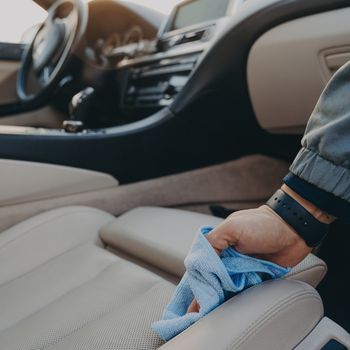 Perhaps the lid on your coffee cup wasn’t secure and the liquid spilled all over your passenger seat. Regardless of how messes occur, spills can have a pervasive effect on vehicles. They can stain upholstery, cause mold growth and rusting or result in a sour smell that doesn’t goes away.
Perhaps the lid on your coffee cup wasn’t secure and the liquid spilled all over your passenger seat. Regardless of how messes occur, spills can have a pervasive effect on vehicles. They can stain upholstery, cause mold growth and rusting or result in a sour smell that doesn’t goes away.
Rather than accepting these accidents as part of car ownership, learn how to properly clean up spills.
Protective Measures
The best protective measure against spills is prevention. Based on your car’s design:
- Vinyl seats are less likely to absorb liquids, including food, moisture, oil-based substances and gasoline. These materials can be wiped down periodically to maintain their appearance.
- Stain and odor-resistant materials are designed to withstand liquids, oils, food and sweat, while maintaining their appearance.
- Seat covers create a barrier for traditional cloth upholstery.
- Rubber mats on the floors help catch moisture and spills before they’re absorbed by the carpet.
Have the Right Cleaning Supplies
An upholstery cleaner, baking soda, towels, a soft-bristled brush and vacuum are needed to fully remove the residue of spills from your car. A wet-dry vacuum is also recommended.
Don’t Wait to Clean Up Messes
If you can, clean up the spill right away. This prevents the stain from setting, creating an odor and becoming more difficult to clean:
- Remove any hard or solid debris first
- Blot up and absorb any liquid
- Apply baking soda to get rid of odors
- Use upholstery cleaner to reduce staining
Cleaning Liquid Spills
After you’ve absorbed as much of the liquid as you can:
- Wet your cloth in water first to help remove any dyes
- Apply pressure until the area is no longer damp
- Avoid rubbing, as this can cause the stain to set
- You may need to press into the seat cushion in case the liquid passed through the upholstery
Cleaning Solid Waste
For food and thicker substances dropped or spilled in your car:
- Remove as many solid particles as you can before they harden
- Soak a towel in hot water to remove liquid, dyes and hardened debris
- Use a soft-bristled brush and upholstery cleaner to focus on tough areas
- Use a wet-dry vacuum to remove any loose particles
Getting Rid of Odors
After you’ve removed most of the spill from your vehicle:
- Apply baking soda to the area and let it sit for a few days
- Use the wet-dry vacuum to clean up the baking soda
- Let the area continue to dry
You may need to re-apply upholstery cleaner and use a soft-bristled brush afterwards if a stain remains.
Cleaning Oil and Gasoline
Similar to the steps described above:
- Use a dry cloth to absorb as much of the spill as you can. Continue pressing until no more liquid is absorbed.
- Apply grease-fighting dish soap to the stain, as this can help get rid of any oil that has soaked into the fabric. You’ll need to scrub the area with a soft-bristled brush.
- Clean up the suds with a wet cloth. Continue going over the area until you no longer see soap.
- Let the area dry fully.
If you’re unable to remove a stain on your own, it may be time for professional interior detailing. Contact DaSilva’s Auto Body to learn more about our upholstery cleaning services.




